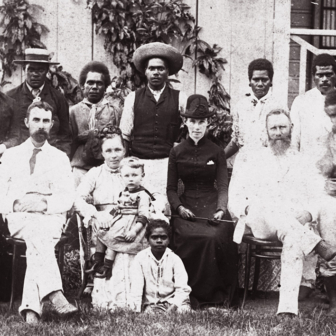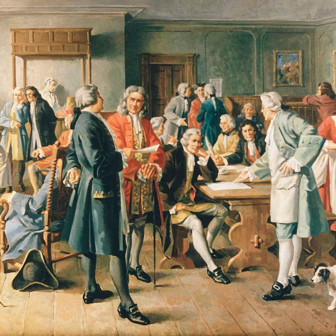What can the European Union tell us about treaty negotiations in Victoria? According to Keith Cherry, a postdoctoral scholar at the Centre for Global Studies at the University of Victoria (the one in Canada, not Australia), quite a bit.
Cherry’s new book, Sovereignty and Contestation, begins with a puzzle. He is attending (participating in?) a rally against the Trans Mountain Expansion Project, a controversial plan to extend the pipeline that carries crude oil and refined products from Alberta to the coast of British Columbia. At the end of the march, near the pipeline terminal in Burnaby, a group of people “come out of nowhere” and “in a matter of hours” construct Kwekwecnewtxw, a traditional Coast Salish watch house. A Tsleil-Waututh woman emerges and explains to the crowd that her people has never ceded authority over their lands, which remain subject to Tsleil-Waututh laws. The Canadian government hasn’t obtained permission to build the pipeline and so is acting illegally. The Kwekwecnewtxw will enable her people to enforce the law.
For the watching officers of the Royal Canadian Mounted Police, it is the Tsleil-Waututh who are acting illegally. The expansion project been approved Canadian authorities. A Canadian court has issued an injunction that makes the protest unlawful. The Watch House has been built — without a permit — on land owned by the Trans-Mountain Corporation.
Sovereignty and Contestation is Cherry’s attempt to make sense of what these competing demands mean not just for our political, legal and economic systems but also for our ethical, political and legal responsibilities. A political theorist by training, he is interested in how states grapple, in practice, with multiple and overlapping sources of law and authority.
He does this in a surprising way, however, by comparing the relationship between Canada and First Nations with the relationship between the European Union and its member states. This apples-to-oranges comparison is unique. A less charitable reader might offer several reasons why the comparison has not been done before (for one, the EU was formed by consensus while First Nations were incorporated by force). Fortunately, as Cherry cogently and carefully explores, the two seemingly contrasting case studies tell us very similar — and fascinating — stories about sovereignty.
In the Western tradition, the idea and practice of sovereignty emerged in Europe during the Middle Ages. Writing amid a civil war, the political philosopher Thomas Hobbes argued that peace and order could only be preserved by a single, all-powerful entity exercising supreme authority. For Hobbes, sovereignty was (and must be) indivisible and absolute. Any limits or divisions of power would lead to instability, violence and chaos.
Around the same time, following thirty years of warfare and strife on the continent, the 1648 Peace of Westphalia signalled a shift in the structure of political organisation. While some anomalies existed (and others still do), the treaty consolidated a trend towards seeing sovereign states as the only legitimate form of political authority — a trend that has since spread across the globe.
But we know this story is too neat. As my international relations professors drilled into me, every state must contend with multiple overlapping sources of authority. Those challenges may come from within, such as Indigenous nations seeking recognition of their inherent authority and political orders, or it may come from without, in the form of transnational corporations or international organisations. To preserve orthodox understandings of sovereignty in a pluralist environment, says Cherry, the state suppresses pluralism “by continually denying, oppressing, co-opting, or absorbing any competing authorities.”
Cherry’s first key claim is that this action — the maintenance of sovereignty’s ideal — itself leads to chaos and violent competition. His argument is compelling. The EU developed out of the ashes of a devastating war sparked not by multilateralism but by its opposite, totalitarian regimes built on the image of an “exclusive, total nature of sovereign power.” As Australia’s Yirrkala bark petitions and the founding of Canberra’s Tent Embassy illustrate, Indigenous protests have carried particular moral and political strength at moments when the state has sought to deny, oppress and absorb their distinct political status.
If sovereignty can’t deliver on its promise of security, Cherry’s second key claim is that pluralism doesn’t necessarily lead to chaos and violence. In stepping slowly through Canadian and modern European history, he outlines how practices have facilitated forms of pluralism that promote peaceful competition, compromise and a rough consensus.
Consider the relationship between EU law and national law. In the 1964 decision of Costa v ENEL, the European Court of Justice established the primacy of European law over the laws of its member states. National courts have, however, issued a range of counterclaims contesting this assumption in ways that promote engagement rather than seek to resolve the question unilaterally. In the Solange decisions, for instance, the German Constitutional Court accepted the supremacy of EU laws “so long as” those laws didn’t violate basic human rights protected in German law. National and supranational legal systems have thus developed in ways that recognise and accommodate the authority claims of the other, subject to certain conditions they have imposed; “as a result, each actor’s authority is autonomous, but contingent.”
The interpenetrated institutions and the conditional authority of the EU are less common in Indigenous–state relations in Canada today. In earlier phases of the relationship, First Nations and national governments recognised each other’s independent claims and engaged in processes of treaty- and agreement-making. The relationship came under challenge from time to time, of course, but peace and security was largely maintained because neither party could expect to exert supreme authority. Pragmatism guided and preceded the development of an “ethic of mutual respect” through which both parties sought to resolve challenges on the basis of dialogue, exchange and treaty.
This was not a golden age. But a constructive means to manage tensions developed because both First Nations and newcomers could contest the terms and content of their relationship, and because they both needed one another. In other words, pluralism — not sovereignty — produced peace.
Perhaps governments recognise this insight? In both Canada and the EU, practices of pluralism continue to chip away at Hobbes’s notion of a sole and undivided sovereign. As Cherry cautions, however, these developments remain stifled by the pull of that older vision of sovereignty.
In Canada, the relationship between First Nations and the state is dynamic and contested, evolving in response to shifting political circumstances and First Nations advocacy. The contemporary landscape is far removed not just from government’s earlier efforts to exercise total control but also from early interactions marked by a genuine nation-to-nation relationship. Modern treaty processes, alongside a host of other agreements and constructive arrangements, recognise the political claims of First Nations and their legal orders. As Cherry notes, however, they largely do so “in ways that affirm settler sovereignty.”
Although not discussed in this book, the Chief Mountain case provides a clear example. In that case, the British Columbia Supreme Court heard a challenge to provisions of the Nisga’a Treaty, which had been negotiated over many years between the First Nation and the provincial and federal governments. The plaintiffs saw as unconstitutional the treaty’s provisions recognising Nisga’a authority to make laws over matters integral to their community, which would prevail over inconsistent federal or provincial laws.
Rather than explore the source of the Nisga’a right to self-government, the court read the treaty as an instrument of delegation. It held that the Canadian and British Columbian parliaments, having invested the Nisga’a with law-making authority, could infringe, modify or withdraw that authority whenever they desired. A treaty may represent “an exchange of solemn promises,” but the state positions itself as the final arbiter as to whether those promises are upheld. Self-government and pluralism is thus made compatible with settler conceptions of sovereignty.
A similar trend is evident in Europe. Whereas the political system and legal orders are marked by pluralism and contestation, the economic dimensions of the EU have become increasingly technocratic. The co-decision mechanisms that do exist — the European Central Bank, for example — have given official technocratic organisations the capacity to influence others without being influenced in return. By analysing the Euro crisis, Cherry demonstrates that economic policy-making in the EU is insulated from contestation in a manner that embraces the traditional ideal of sovereignty — “order is most secure where authority is most concentrated, and contestation is least present” — with disastrous consequences for actual order and security.
In his careful and sophisticated account, Cherry sweeps away anxieties around pluralism and chaos. It turns out that totalising accounts of sovereignty actually spark contest and conflict, while peace and order is facilitated by mechanisms that support constructive engagement across and between multiple sources of authority. This is a significant achievement, and Cherry should be congratulated for his accessible and erudite scholarship — particularly in bringing into conversation two wildly distinct literatures.
But he is less clear about how mechanisms of genuine pluralism and multilateralism can be developed. He clearly supports systems of popular control and democratic contestation, but his retelling of European integration appears to praise the protagonists for ignoring the views of their populace. Multilateral institutions were built to escape the nationalism and fascism that would naturally arise from a system of sovereign states, but this was done largely without recourse to the views and interests of the people of those states because the founders of the EU “worried that the public at large” would not share their vision.
Drawing on Jeremy Webber’s influential analysis, Cherry nonetheless suggests that over time these institutions have developed a normative force. The EU has drawn together adversaries who now speak a shared language and operate within a common structure. Though it may not have been supported at the time of its creation, those institutions have generated a shared ethical commitment. As Robert Williams Jr might say, these treaties have connected Europeans “through constitutional bonds of multicultural unity.”
So, what does Cherry’s argument suggest about the current treaty negotiations in that other Victoria, Australia’s southeastern mainland state? Four points can be drawn out. First, we should not be surprised that opposition to the treaty process is often couched in the language of sovereignty. Opponents argue that recognising the inherent rights and status of First Peoples in Victoria will fracture the political community, divide Victorians into two classes, complicate governance and administration, and ultimately lead to turmoil.
Cherry’s analysis helpfully articulates why this is unlikely to occur. A statewide treaty will create opportunities for the dialogue, discussion and contestation that make good governance possible. It will ensure that First Peoples are included in matters that concern them rather than compelled to challenge and contest actions because of their exclusion.
Second, the Victorian treaty — the first formal Indigenous-state treaty in Australian history — will mark a significant moment for the country. As an instrument operating within Australian law and the Australian legal order, however, it won’t remove the deep asymmetries in the relationship between Indigenous Australians and the state. On its own, it won’t create the conditions of pluralism necessary to produce a stable and prosperous peace.
We might do better, then, to conceive the Victorian treaty as one part of a layered and patterned landscape of engagement, dialogue and negotiation that promotes and facilitates practices of pluralism in Victoria. Opportunities for pluralism will remain stifled by our sovereign anxieties, but as iterative, ongoing and incomplete processes, treaties, agreements and other constructive arrangements might offer a path towards a different vision.
Nonetheless, and thirdly, sustaining that vision may be challenging. Our constitutional framework means that an Indigenous–state treaty is legally vulnerable. Legislation to implement the treaty may be repealed or annulled by a future Victorian or federal parliament. In these circumstances, sustained effort has focused on building awareness, support and ownership of the treaty process within the community; of building a “treaty ethic” that will legitimate it within the political order.
This is critical work, but Cherry’s analysis suggests that an ethic of pluralism will only develop in circumstances of mutual need, when both communities must work together. That could come from a sustained direct-action campaign by First Peoples’ demanding action and paralysing industry or government, or from new treaty institutions that facilitate and require engagement.
In the current environment, the former approach appears more likely to derail negotiations, leaving us reliant on the latter. This is risky. On Cherry’s account, the ethic required to support a treaty in Victoria will only emerge and be sustained after its successful negotiation and implementation.
We can be encouraged that institutions and processes that facilitate First Peoples co-decision-making and autonomy will generate support, but they must first be established. Until then, the government and the First Peoples’ Assembly must continue to negotiate in the hope and expectation that sustained popular support will follow. Will it? Given the Liberal–National opposition remains committed to withdrawing from the treaty process, the state election in November 2026 looms large.
Notwithstanding all of this, the fourth point to be drawn from Sovereignty and Contestation is its optimism. When I commenced my PhD studies, which explored the relationship between Aboriginal and Torres Strait Islander peoples and the Australian state, my supervisors told me that I should be optimistic and push my argument to its boundaries. Despite the great hardships it has imposed on Indigenous Australia, the most important characteristic of the law and its greatest power is its capacity to change: to change systems, institutions, structures, lives. But change requires vision, and that requires belief in the capacity for change. Optimism helps.
We may well be closer to systems of genuine pluralism than we think. Simple steps, such as the decision to put aside difficult arguments and work together, can carry us forward still. The 2009 Kunst’aa Guu–Kunst’aayah Reconciliation Protocol is one such example. This agreement, negotiated by the Haida Nation and British Columbia, begins with a preamble laying out the parties’ incommensurable positions but nonetheless committing to a constructive partnership:
WHEREAS:
1. The Parties hold differing views with regard to sovereignty, title, ownership and jurisdiction over Haida Gwaii, as set out below.
The Haida Nation asserts that:
Haida Gwaii is Haida lands, including the waters and resources, subject to the rights, sovereignty, ownership, jurisdiction and collective Title of the Haida Nation who will manage Haida Gwaii in accordance with its laws, policies, customs and traditions.British Columbia asserts that:
Haida Gwaii is Crown land, subject to certain private rights or interests, and subject to the sovereignty of her Majesty the Queen and the legislative jurisdiction of the Parliament of Canada and the Legislature of the Province of British Columbia.Notwithstanding and without prejudice to the aforesaid divergence of viewpoints, the Parties seek a more productive relationship and hereby choose a more respectful approach to co-existence by way of land and natural resource management on Haida Gwaii through shared decision-making and ultimately, a Reconciliation Agreement.
This approach has facilitated productive dialogue. In 2024, the province and the Haida Nation signed the Gaayhllxid/Gíihlagalgang “Rising Tide” Haida Title Lands Agreement, recognising the jurisdiction and title of the Haida Nation to Haida Gwaii. In just fifteen years, a mighty river was forded.
A similar process may be underway in Victoria. The preamble to the Advancing the Treaty Act with Aboriginal Victorians Act 2018 records that “Victorian traditional owners maintain that their sovereignty has never been ceded…” While the Act makes no comment on this statement, the almost ten years of structured engagement and dialogue during the treaty process might soon prompt the state to reconsider its position. Pluralism exists; we just need to accept it — and, as Cherry would argue, enjoy the peace and prosperity it promises. •
Sovereignty and Contestation: Practices of Pluralism in Canada and the European Union
By Keith Cherry | University of Toronto Press | C$39.95 | 264 pages




